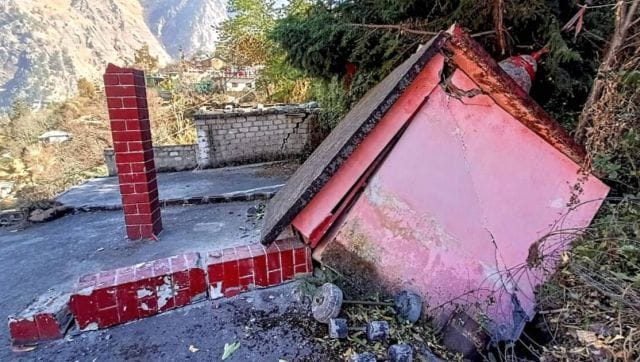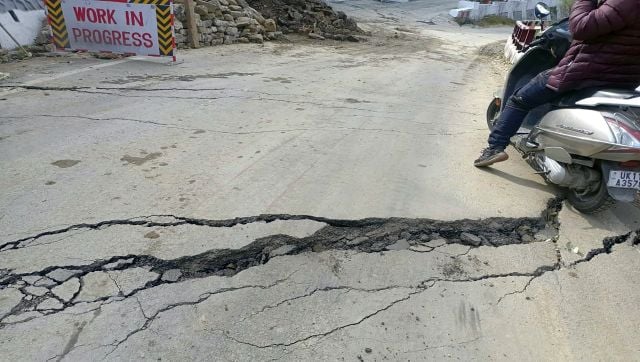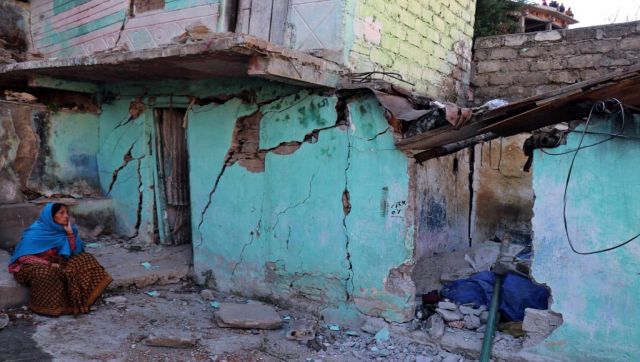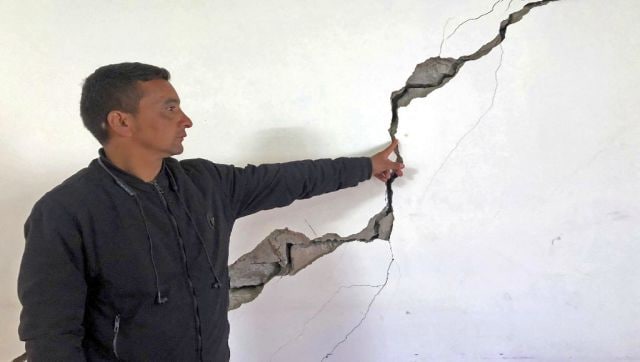Joshimath declared as ‘landslide-subsidence zone’: What does this mean for the residents of Uttarakhand town?
Joshimath declared as ‘landslide-subsidence zone’: What does this mean for the residents of Uttarakhand town?

‘Joshimath is sinking’, ‘That sinking feeling in Joshimath’ — these are the headlines that have been circulating around the country for more than four days now. But for the residents living in the Uttarakhand city, it’s a lived reality. They stare at their homes and roads developing massive cracks, fuelling fear and panic among the residents.
On Sunday, the matter was at the heart of discussions at a Prime Minister’s Office meeting with officials later declaring the holy city — where the Jyotirmath Hindu monastery is located — as a landslide-subsidence zone. Over 60 families have been evacuated to temporary relief centres and, officials said, another 90 families have to be evacuated.
Joshimath land subsidence | Cracks observed on 603 buildings, 68 families relocated. #Uttarakhand pic.twitter.com/hoCBAvQzBY
— ANI UP/Uttarakhand (@ANINewsUP) January 8, 2023
At the meeting, government officials and state officers were also told to adopt a “whole of government approach and work together to contain the situation, undertake continuous seismic monitoring, prepare a time-bound reconstruction plan, and develop a risk sensitive urban development plan.
As officials grapple with the worsening situation and locals pray for safety, we take a closer look at what does it mean to be a landslide-subsidence zone and how serious is the situation in Joshimath.
Land subsidence, explained
The United States Geological Survey describes land subsidence as a gradual settling or sudden sinking of the Earth’s surface due to removal or displacement of subsurface earth materials. According to the American body, subsidence is a global problem, and in the United States more than 17,000 square miles in 45 states have been directly affected by subsidence.
Subsidence is most often caused by the removal of water, oil, natural gas, or mineral resources out of the ground by pumping, fracking, or mining activities. This feature can also be caused by natural events such as earthquakes, soil compaction, erosion and sinkhole formation.
Land subsidence can be attributed to natural causes, human activities, or both. Understanding land subsidence in coastal cities is important for adapting to #sealevelrise.#FactFriday pic.twitter.com/JLlpwFzQ6F
— Earth Observatory SG (@EOS_SG) July 29, 2022
National Oceanic and Atmospheric Administration notes that subsidence can occur over very large areas such as whole states or small corners such as a person’s garden.

Land subsidence isn’t a new phenomenon in India; studies have shown that certain parts of Delhi like Kapashera, near the Indira Gandhi International airport, has seen land subsidence, with this specific land sinking at the rate of 11 cm per year during 2014-2016, which grew to more than 17 cm per year during the two years that followed.
In India, the main cause of subsidence is the unregulated pumping of groundwater and the rapid pace of urbanisation.
Such is the severity of land subsidence that experts estimate that by 2040, land subsidence will affect eight per cent of the world’s surface and an approximate 1.2 billion people living in 21 per cent of the major cities across the globe.
It is also said that land subsidence will impact Asia more than other parts of the world. With 86 per cent of the Asian population exposed to effects of land subsidence, about $8.17 trillion is potentially at stake.

Effects of land subsidence
Land subsidence can cause the settlement of clay on the upper levels — leading to damage of infrastructure (roads, bridges) and flooding due to ineffective drainage systems of the city. Experts cite that it could impact houses and other infrastructure, making them weaker, and also lead to the weakening of foundations or develop cracks in the buildings (exactly what is happening in Joshimath).
This phenomenon can also cause earthquakes in the area. Land subsidence can be very serious. A 2014 report had stated that land subsidence had caused a loss of around $.15 billion in China.
Joshimath is sinking
Residents of Joshimath have said that while the cracks aren’t new to them, they have accelerated in the last few days. The Garhwal commissioner Sushil Kumar echoing the same said to news agency PTI, “Land subsidence has been going on slowly in Joshimath for quite some time but it has increased over the past week with huge cracks appearing in houses, fields and roads.
“The situation worsened apparently after a water channel beneath the town erupted last week,” he said.
A recent survey has also revealed that of the total 4,500 buildings in the area, 610 of them have developed huge cracks, making them unfit for habitation.
Also read: Split Wide Open: Inside Joshimath, Uttarakhand's 'sinking' holy town

Experts commenting on the issue, say that the problem has long existed, but has been ignored. Environmentalists have said that the biggest reason for Joshimath’s sinking is related to the geography of the town. They explain that the landslide debris on which the city was established has a low bearing capacity and cannot support a high rate of construction. Increased construction, hydroelectric projects, and the widening of the National Highway have made the slopes highly unstable in the last couple of decades.
Joshimath (Thread)
In 1976, There was a Mishra committee report that clearly said that
1. Joshimath is built on a fault plane (dotted line in left pic is fault plane and what is fault plane explained in right pic)
2. Joshimath is built on a landslide material1/14 pic.twitter.com/YVlUD9AXgg
— Agenda Buster (ST⭐R Boy) (@Starboy2079) January 7, 2023
Professor Yashpal Sundriyal of Hemwati Nandan Bahuguna University’s Geology Department speaking to News18 said that excessive building and drainage problems are to be blamed.
According to Anjal Prakash, faculty member at ISB Hyderabad and Intergovernmental Panel on Climate Change author on Joshimath has said that the tunnel building for the upcoming hydropower project is the biggest cause for land subsidence in the area.
This view has also been echoed by local environmental activist Atul Satti. He says that despite their repeated warnings, the work has continued. “Our voices were blatantly ignored and our worst nightmare has come true today. The entire responsibility of Joshimath caving in is on NTPC's Tapovan Vishnugad Hydro Power Project,” he was quoted as telling IANS.

“Continuous blasting in the tunnels have shaken the foundation of our town. We demand instant action from the government that must include immediate stalling of NTPC project, closure of Chardham all-weather road (Haleng-Marwari Bypass), implementation of NTPC’s pact that insures houses, setting a committee for rehabilitation of Joshimath within a set timeframe.”
Professor Sundriyal further explained that the increased population is also to blame. “The ongoing crisis in Joshimath is primarily because of anthropogenic activities. The population has increased manifold and so has the tourist landfall. The infrastructure development has been going on unchecked. The construction of the tunnels for hydropower projects is being done through blasting, creating local earthquake tremors, shaking debris above the rocks, leading to the cracks,” Sundriyal said.
Residents of Joshimath, meanwhile, stare at an uncertain future.
Durga Prashad Saklani, 53, residing in the Sunil area in Joshimath said that his house, which he built barely eight months ago has developed such huge cracks that he had been forced to place wooden logs to prevent the roof from crumbling. Speaking to Times of India, he said, “My family of 15 has been asked to vacate our house and shift to a nearby hotel. But for how long are we going to stay there?”
Rajni, a teacher employed with a private school in Joshimath and a resident of Manohar Bagh, told Hindustan Times: “We are staring at an uncertain future. The school where I work may vanish too.”
She added that she and her family have asked them to shift to a hotel, but she worries what if the accommodation provided also develops cracks. “I am concerned about the safety of my daughter and son. Though the government says we should shift to hotels and other accommodations made available by them, what if they develop cracks too,” she said.
With inputs from agencies
Read all the Latest News, Trending News, Cricket News, Bollywood News,
India News and Entertainment News here. Follow us on Facebook, Twitter and Instagram.
What's Your Reaction?

























































